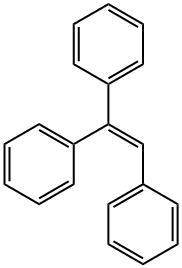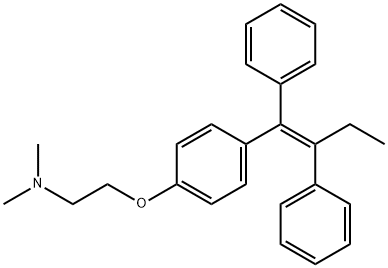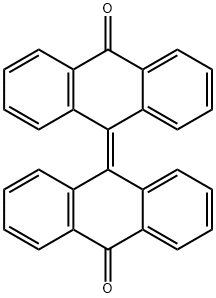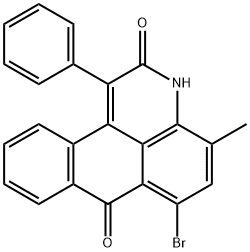Triphenylethylene
- CAS NO.:58-72-0
- Empirical Formula: C20H16
- Molecular Weight: 256.34
- MDL number: MFCD00004765
- EINECS: 200-395-1
- SAFETY DATA SHEET (SDS)
- Update Date: 2025-07-04 15:13:27

What is Triphenylethylene?
Chemical properties
White to slightly beige powder
The Uses of Triphenylethylene
Triphenylethylene is used in preparation of Esterase activated aggregation-induced luminescent anticancer prodrug.
Definition
ChEBI: Triphenylethylene is a stilbenoid. It is the core chemical structure of a number of related anti-estrogen compounds. The triphenylethylene antiestrogens, which include idoxifene, toremifene, chlorotrianisene, raloxifene and tamoxifen, act at the level of the estrogen receptor, triggering inhibition or stimulation of estrogen-dependent gene transcription and cellular physiology.
Synthesis Reference(s)
Journal of the American Chemical Society, 78, p. 82, 1956 DOI: 10.1021/ja01582a025
Organic Syntheses, Coll. Vol. 2, p. 606, 1943
Tetrahedron Letters, 14, p. 4193, 1973
Safety Profile
Experimental reproductive effects. Questionable carcinogen with experimental tumorigenic data. Human mutation data reported. When heated to decomposition it emits acrid smoke and irritating fumes.
Properties of Triphenylethylene
| Melting point: | 69-71 °C (lit.) |
| Boiling point: | 219-221°C 14mm |
| Density | 1.0373 |
| refractive index | 1.6292 |
| Flash point: | 219-221°C/14mm |
| storage temp. | Store below +30°C. |
| color | White |
| BRN | 1867462 |
| CAS DataBase Reference | 58-72-0(CAS DataBase Reference) |
| NIST Chemistry Reference | Benzene, 1,1',1''-(1-ethenyl-2-ylidene)tris-(58-72-0) |
| EPA Substance Registry System | Triphenylethylene (58-72-0) |
Safety information for Triphenylethylene
| Signal word | Warning |
| Pictogram(s) |
 Exclamation Mark Irritant GHS07  Environment GHS09 |
| GHS Hazard Statements |
H302:Acute toxicity,oral H319:Serious eye damage/eye irritation H410:Hazardous to the aquatic environment, long-term hazard |
| Precautionary Statement Codes |
P273:Avoid release to the environment. P305+P351+P338:IF IN EYES: Rinse cautiously with water for several minutes. Remove contact lenses, if present and easy to do. Continuerinsing. P501:Dispose of contents/container to..… |
Computed Descriptors for Triphenylethylene
New Products
Indole Methyl Resin tert-butyl 9-methoxy-3-azaspiro[5.5]undecane-3-carboxylate Boc-His(Boc)-OH 2-CTC Resin 4-Chloro-7-tosy1-7Hpyrrolo[2,3-d]pyrimidine 5,7-Dibromo-1H-indole 2,5-dichloro-N-hydroxy-4,6-dimethylpyridine-3-carboximidamide 2,2-Dimethoxy-7-azaspiro[3.5]nonane hydrochloride 4-chloromethyl-5-methyl-1,3-dioxol-2-one (DMDO-Cl) R-2-BENZYLOXY PROPIONIC ACID 1,1’-CARBONYLDIIMIDAZOLE 1,1’-CARBONYLDI (1,2-4 TRIAZOLE) N-METHYL INDAZOLE-3-CARBOXYLIC ACID 4-((2-hydroxyethyl)thio)benzoic acid 1-(TERT-BUTOXYCARBONYL)-2-PYRROLIDINONE Methyl 6-methylnicotinate 3-Pyridineacrylic acid tert-Butyl carbazate TETRAHYDRO-2H-PYRAN-3-OL 2-((4-morpholinophenylamino) (methylthio) methylene) malononitrile 3-(4-morpholinophenylamino)-5-amino-1H-pyrazole-4-carbonitrile 2,4-dihydroxybenzaldehyde 1,3-Diethyl-1,3-Diphenylurea Methyl 2-methylquinoline-6-carboxylateRelated products of tetrahydrofuran








You may like
-
 58-72-0 1,1,2-triphenylethylene 99%View Details
58-72-0 1,1,2-triphenylethylene 99%View Details
58-72-0 -
 Triphenylethylene CAS 58-72-0View Details
Triphenylethylene CAS 58-72-0View Details
58-72-0 -
 Triphenylethylene 95% CAS 58-72-0View Details
Triphenylethylene 95% CAS 58-72-0View Details
58-72-0 -
 Triphenylethylene CAS 58-72-0View Details
Triphenylethylene CAS 58-72-0View Details
58-72-0 -
 TriphenylethyleneView Details
TriphenylethyleneView Details
58-72-0 -
 Pyridine 99.5% HPLC /UV SpectroscopyView Details
Pyridine 99.5% HPLC /UV SpectroscopyView Details
110-86-1 -
 Dibutyl PhthalateView Details
Dibutyl PhthalateView Details
84-74-2 -
 Thiourea 99% ARView Details
Thiourea 99% ARView Details
62-56-6
